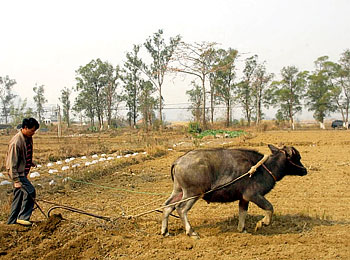| Tools: Save | Print | E-mail | Most Read |
| Low Income, Poverty and Aging - Rural Difficulties |
| Adjust font size: |
The two major problems of China's rural areas, slow income growth and vulnerability to poverty, have been joined by an aging population, which is emerging as the new Achilles heel of rural development, according to the latest Study Times issued by the Chinese Communist Party School.
By the end of 2004, China had 757 million rural residents, making up 58.2 percent of the total population. To some extent this large group of people are China's most socially vulnerable as their access to natural and social resources is extremely limited. In 2004, after seven years' struggle, the income of rural residents jumped out of the doldrums and increased by 6.8 percent, a record high since 1997. Between 1979 and 1983 the average annual growth was over 10 percent and there were two years in which it was above 19 percent. However, apart from the growth of 9 percent in 1996 promoted by a good harvest and a rise in grain prices, from 1986 to 2003 the increasing rates were all lower than those of 2004. The highest was 6.4 percent in 1988 and the lowest was minus 1.6 percent in 1989. The incomes of rural residents come from four main activities: small family workshop businesses and selling grain, the salaries earned by migrant workers, transferred income (such as heritage, gifts, allowances and so forth) and property income. For instance, compared with the previous year, in 2004 the per capita income of a small family workshop business and sale of grain was 1737.7 yuan (US$217.2), increasing 12.2 percent; the salary income reached 991.4 yuan (US$123.9), up 9.4 percent; transfer income hit 145.1 yuan (US$18.2), a rise of 23.9 percent and property income was 63.1 yuan (US$7.9), growing 6.7 percent. After more than 20 years' reform and opening up, the poverty-stricken population has been reduced to 26.1 million from 250 million and the poverty ratio has dropped to 2.8 percent from 30 percent. But the poverty line criterion of rural residents is very low: 668 yuan (US$83.5) of per capita net income that can only buy about 400 kg of grain. Due to poor living conditions and uncertain income sources, residents in rural areas are vulnerable to poverty. The aging population also makes fighting poverty more difficult. In 2005 the number of people over 65 years old topped 100 million. Younger people drift to urban areas to earn some extra money for their families, leaving old parents and wives at home to take care of the farm. The cost of the current development of urban areas is the aging population of those rural regions. This state of affairs should be the first problem to be resolved in the anti-poverty campaign. (China.org.cn by Wang Ke, August 18, 2006) |
| Tools: Save | Print | E-mail | Most Read |
 |
| Related Stories |
| Product Directory China Search |
Country Search Hot Buys |
